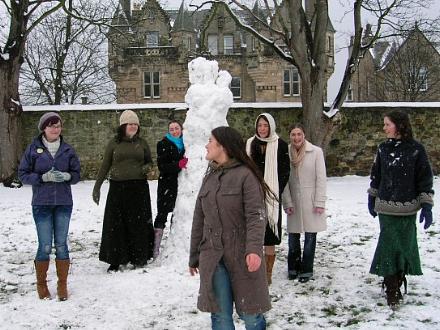World
About Andrew Cusack
 Writer, web designer, etc.; born in New York; educated in Argentina, Scotland, and South Africa; now based in London.
Writer, web designer, etc.; born in New York; educated in Argentina, Scotland, and South Africa; now based in London. read more
News
Blogs
Reviews & Periodicals
Arts & Design
World
France
Mitteleuropa
Knickerbockers
Argentina
The Levant
Africa
Cape of Good Hope
Netherlands
Scandinavia
Québec
India
Muscovy
Germany
Academica
Clerics of the Old School
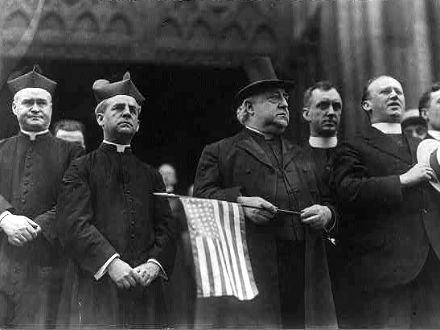
Msgr. Lavelle and others review the 69th N.Y. Regiment from the steps of St. Patrick’s Cathedral, 21 June 1916.
Previously: Your Royal Highness, Caed Mile Failte | Fighting 69th: Home for St. Patrick’s Day
Words of Wisdom
I’d like to thank Field Marshal Rommel for vindicating my life.
A Mighty Headache
Ask not for whom the bell tolls, it tolls for thee…
As I sat in bed this morning, hearing the bells of St. Salvator’s summoning the studentry from their cozy chambers to the hebdomadal chapel service, the fifteen minutes of tolling summoned naught but two thoughts from the deep recesses of my brain: doom and misery. The reader will forgive this rather grim introduction, but grim was precisely the feeling in the ascendant this morning. I shall continue by retreating to the beginning.
The merriment began at about one o’clock in the afternoon in the Central bar, as have many a session of merriment and good laddery. My good friend Chris C. was visiting the Royal Burgh for the weekend and we decided to head to the Central for a smooth, satisfying pint of John Smith’s, which is the preferred tipple for joint C./Cusack operations. Making our way to that public house, we chanced upon none other than Manuel Pantelias Garces, the little fellah who packs a tremendous punch, and invited him to join in our imbibing of Yorkshire ale.
And imbibe we did. We had one pint of John Smith’s, followed by another, then another, and then another until I swept over to Step Rock Cottage to be fashionably late for Jon and Abby’s engagement party. There, for some unknown reason, I declined copious amounts of Louis Jadot instead deciding to drink down a mighty torrent of Bucks Fizz. In a jocular and celebratory mood, I decided to purchase a ticket to tommorrow’s charity polo tournament off Richard Holtum, and discussed various things with Adrian and young Miss Tori Truett who had popped up from London to grace us with her beauty and wit. (more…)
Old Speckled Hen
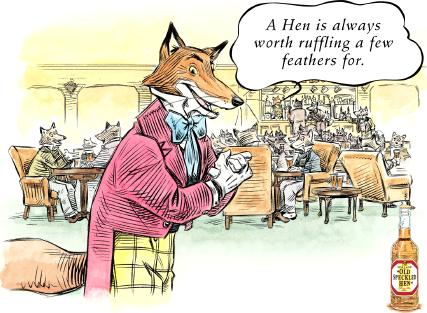
Spring has come late to Fife this year, but I do think we’re all the better for it. One appreciates so much more these spriteful spring days after a longer dark season, though in all honesty I already partly miss the many snowy days we enjoyed in St Andrews this winter. How splendid it is to warm oneself by the fire on a cold winter’s day, with a cup of coffee or a pint of ale and some Washington Irving to read. None of that today, however!
Quite a decent day, really. The eleven o’clock Mass saw a good friend received into the Church, followed by her Confirmation along with another friend of mine. After the post-Mass tea and coffee, myself, young McMorrin, Tom Howard, Adrian, Miss Brennan, Michelle, and Miss Dempsey got sandwiches from Cherries and enjoyed the sun-soaked ruins of the Cathedral cloister. I had a delicious honey mustard chicken and stuffing brown-bread baguette, splendidly washed down with a bottle of Old Speckled Hen. (more…)
Some Photographs
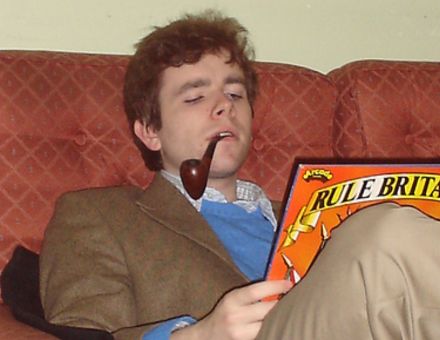
A young lass of Ulster claims I look “adorably marriageble” in this photograph. (more…)
Bronxville Library
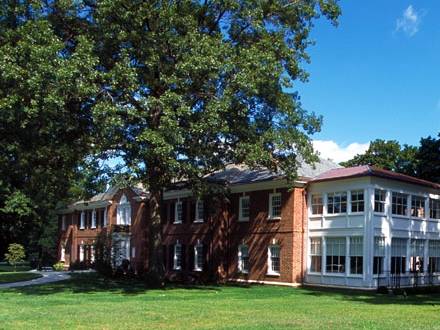
I do miss my library. In a perfect world, I would spend half the day wandering through various libraries of lower Westchester and the City. Of course we have a university library here in St Andrews, but its selection is fairly poor, especially in the subjects in which I am particularly interested. (more…)
Recent American Heraldry
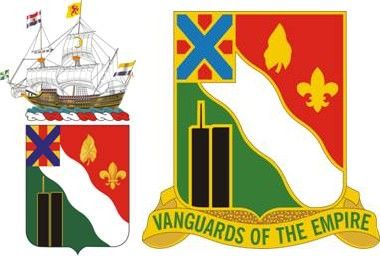
The Army Institute of Heraldry on 7 April 2006 approved a new coat-of-arms (left) and Distinctive Unit Insignia (right) for the 104th Military Police Battalion. According to the information provided by TIOH (as the Institute goes by), the red in the shield represents the unit’s role as a Field Artillery Battalion during World War II, while the green signifies the military police. The taro leaf represents the unit’s service in Hawai’i during the Spanish-American War, while the fleur-de-lis stands for service in France during both World Wars.
The black silhouette of the World Trade Center, a unique heraldic innovation, honors members of the unit who died in the Twin Towers on September 11, as well as the members of the battalion deployed to Manhattan. The service of earlier component units are represented in the canton. The red cross of St George symbolizes the War of Independence, while the blue saltire of St Andrew (akin to that of the Confederate battle flag) symbolizes the Civil War.
In blazonry, the language of heraldry, the shield is “per bend Gules and Vert, a bend wavy Argent, to chief a taro leaf and fleur-de-lis in bend Or; issuing from base the silhouette of the Twin Towers Sable edged of the fourth; on a canton of the last a cross Gules surmounted by a saltire Azure”. The crest is that which is standard to all New York Army National Guard units, depicting the Halve Maen on which Hudson explored New York harbor and his eponymous river. It is blazoned “from a wreath Argent and Gules, the full rigged ship “Half Moon” all Proper”.
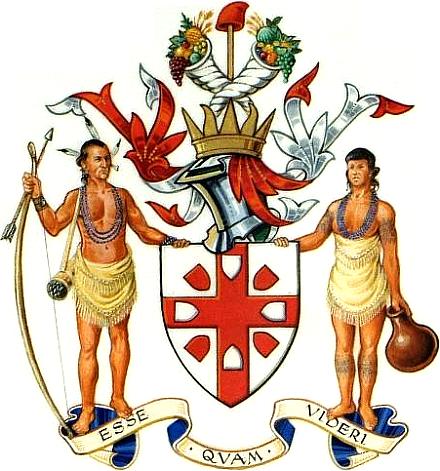
Meanwhile, the President of the Senate of North Carolina petitioned the College of Arms in London for a coat of arms for the upper house of the state legislature. The devisal by Letters Patent of Arms, Crest, and Supporters was made 25 November 2005 by Garter, Clarenceux, and Norroy and Ulster Kings of Arms. The eight little shields (known as escutcheons in blazonry) on the main shield allude to the eight proprietary Lords of the Province of Carolina. The colonial grant for Carolina was one of the most feudal, allowing the Lords of Carolina to grant minor hereditary titles of nobility, and in terms of heraldry allowed for the appointment of a Carolina Herald to grant arms independently of the College of Arms in England. The noble coronet atop the shield is apparently one of the heraldic ornaments worked out in 1705 for landgraves and cassiques in the Province of Carolina.
The shield of the coat of arms of the Senate of North Carolina is blazoned as “Argent on a Cross between four Escutcheons bases inwards Gules four Escutcheons bases also inwards Argent” while the crest is “Issuant from a Coronet of a Noble of the former Province of Carolina Or a Cap of Liberty Gules raised upon a Pole Or between two Cornucopiae in saltire Argent replenished proper”. The supporters are “On each side an Aborigine of North Carolina as depicted by John White in the reign of Queen Elizabeth the First that on the dexter a Warrior supporting with his exterior hand a Long Bow and holding an Arrow girded at his back a Quiver that on the sinister a Woman holding in her exterior hand a Gourd all proper”.
An interesting note: the lower house of North Carolina’s General Assembly was known as the House of Commons until the conquest of the South during the Civil War.
Images from the United States Army Institute of Heraldry and the College of Arms respectively.
Father & Son
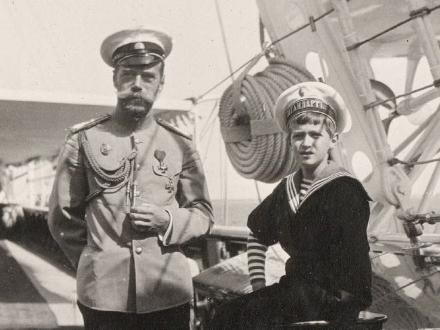
These photos of Czar Nicholas II and his son, the Czarevich Alexei, are from the Romanov family photo album which somehow ended up in the Beinecke Library at Yale University. Nicholas and Alexei, along with their entire family, were murdered by the Communists in the basement of a house in Yekaterinburg, Russia on the night of July 17, 1918. The family having since been canonised (or ‘glorified’, as it’s called in the Russian church) as saints, a cathedral now stands on the site of their murders. (more…)
Chinatown Bus Terminal
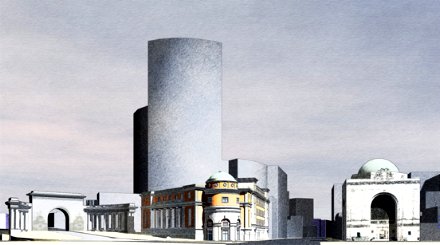
Chinatown’s Fung Wah bus is famously one of the cheapest ways to get to Boston, costing only only $15 to get to New York’s most northerly suburb. The preferred mode of transport between home and university for many a student and an economical mode of transport for the traveller-in-the-know, the chief deficiency of the ‘China bus’ as it is known is that in New York it just lets you off on a random street corner at the eponymous end of the Manhattan Bridge. Wendan Tang, a graduate student at Notre Dame’s School of Architecture (arguably the best in the country), produces his solution to the problem with a hypothetical design for a bus terminal in Chinatown, nudged between the bland modern Confucius Plaza and the beautiful classical entrance collonade and arch of the Manhattan Bridge.
I am an Uncle
Hot dang, what a break! I am now safely entrenched in my humble little chamber in St. Salvator’s Hall, North Street, Royal Burgh of St. Andrews, Kingdom of Fife, Scotland, United Kingdom of Great Britain and Northern Ireland, God’s Own English-Speaking World, the Planet Earth, the Milky Way, the Universe, the Mind of God. The first week of my two-week vacation, you will no doubt recall, was spent in the Eternal City: Roma, Caput Mundi. I had not been to Europe in six years, I believe, and since that time the entire continent has adopted Monopoly Money as the official currency. Johnny Foreigner, what will he do next! Despite being in Europe, it is Rome after all, and thus both the birthplace and font of Western Civilization. A suitably humbling experience. Brilliant.
Then an exceedingly brief foray to Trinity College Dublin in our neighbourly Republic to have a few pints and some damn good laughs with one of the leaders of Youth Defence, Ireland’s main pro-life group, (I would give his name but it’s Gaelic and thus impossible to spell) and to hear an update on the general state of things large and small in Éire. Despite being civilised English-speakers over there, they seem to have adopted the Monopoly Money as well. Odd.
Then to Somerset (or ‘Zomerzet’ as the endearing locals call it) to the great Basilica and Monastery of Saint Gregory the Great, founded at Douai in France, removed to Acton Burnell in England to escape the nefarious and ungodly French Revolution, and currently located at a place most commonly called Downside. Our good friends Robert and Maria O’Brien upheld their usual high standard of entertainment. A week in the English countryside is a most enjoyable thing after having spent week on the Continent, perhaps even necessary. Last night, Jon and Abby joined us since they were in nearby Bristol and we all got drunk as lords. To top it all off, Pop called heralding the birth of Master Finn Daniel Larson, thus elevating me to Unclehood. Well, as you can imagine, we had even more to drink after hearing that news. Splendid!
Well friends, you can appreciate the need for a little rest and relaxation, even though I just spent a week resting and relaxing at Downside, so I will bid you adieu for now. You can expect a full report on our amazing Roman expedition within the next few days.
Tennis, Anyone?
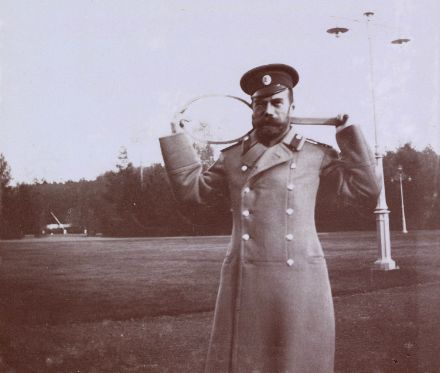
I don’t know how that translates into Russian.
A Victory for Common Sense

In a shocking defeat for the Hacks, Tom d’Ardenne has been elected President of the University of St Andrews Students Association, though not without a fight! First, the background.
What is the Hack? The Hack is a strange subspecies of human which populates the myriad committees and offices of the Students Union. They are vile, strange, self-delusional people who live in an alternative universe purely of their own creation. The Hack is the enemy of all that is good and holy and sensible in this world. They have committee meetings which are hours long and which achieve nothing. They devote indordinate amounts of time to the Students Association, and to no real use. The Union (and all its works and worthless pomps) has absolutely no bearing, impact, or influence on the lives of the overwhelming majority of students. Hacks pretend this isn’t so, and when they are confronted with this reality (usually by injurious ne’erdowells such as myself), the reactions vary from the hilarious to the pitiable.
Nonetheless, the free reign the hacks have in the union has led them to create an intricate code of complex rules, regulations, and decrees. The hack has spent years studying and being inculcated in this strange Justinian code of darkness, which makes it intrinsically difficult for any non-hack to win any union election. First of all, the electoral rules can punish a candidate for factors completely outside his control. If you’re running for office and someone you don’t know, have never met, and have nothing to do with has completely unknowingly violated some minutiae of a footnote of a rule, you can be punished for it. Even thrown out of the race!
This is what happened to dear old Tom, the non-hack, the anti-hack. But with appeals and tribunals and what have you, somehow common sense prevailed and it was decided that his votes would be counted along with the others. And when the votes were counted, it was announced that the Anti-Hack himself had been duly elected Association President! Of course, it doesn’t really mean much. It’s largely a figurehead position as he has no real power to abolish, reform, or streamline the Union. But it’s an important symbolic victory against the hacks and their reign of self-importance. Plus, it’s always somewhat comforting to know that nice guys don’t always finish last. Our most profound congratulations to Tom d’Ardenne and best wishes for his sabbatical year as the head student representative of our ancient university. Do us proud!

Glen Hansen’s Praha
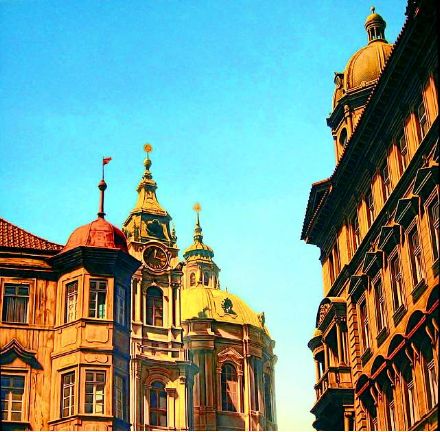
Glen Hansen, Praha – Church of St. Nicholas
Oil on panel, 32″ x 32″
2005, Fischbach Gallery

Glen Hansen, Praha – Trilogy (Homage to Agnes Martin)
Oil on panel, 24″ x 24″
2005, Fischbach Gallery
“Praha” is on display through Saturday, April 15 at the Fischbach Gallery, 210 Eleventh Ave., between 24th and 25th streets. Tue.–Fri., 10:00am–5:30pm, Sat, 10:00am–6:00pm, 212-759-2345, free.
Your Royal Highness, Cead Mile Failte
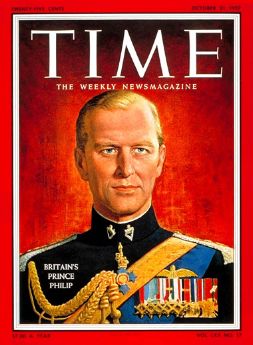
Thus wrote Francis Finnegan of the Ancient Order of Hibernians to H.R.H. Prince Philip, the Duke of Edinburgh, (above, in the uniform of the Queen’s Royal Irish Hussars) inviting him to partake in New York’s St. Patrick’s Day festivities in 1966 during his visit to North America. The invitation was made in recompense for the opprobrious breach of propriety in 1861 when Col. Michael Corcoran, Commanding Officer of the New York 69th committed an act of insubordination when he refused to order his troops to take part in the official festivities welcoming the Prince of Wales to New York. Corcoran was dropped from the Officers Roll of the New York State Militia for the offense, and was to be court-martialled but for the outbreak of the Civil War.
Finnegan, the public relations director of the New York St. Patrick’s Day Parade organised by the Ancient Order of Hibernians every year, assured the Duke of Edinburgh that he would not be mistreated as the Prince of Wales had been one hundred and five years previous. “Alas,” TIME magazine reported, “he arrived in Manhattan too late on St. Patrick’s Day to march in the Fifth Avenue parade, even though he did sport a fine green tie. Britain’s Prince Philip, 44, in a green tie? ‘Just a coincidence,’ chuckled the consort.” (TIME, 25 March, 1966).
The 1861 visit of the Prince of Wales to New York was a spectacular event, despite the insults of Col. Corcoran. A ball was held, just as for the Queen Mother during her 1954 visit to New York, as well as a parade and pass-in-review.
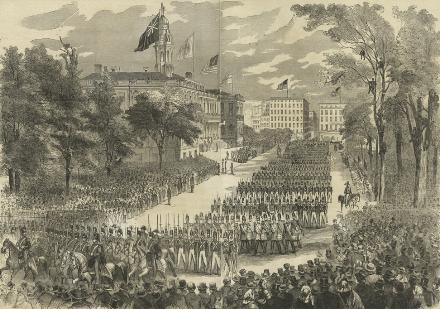
Visit of King Peter
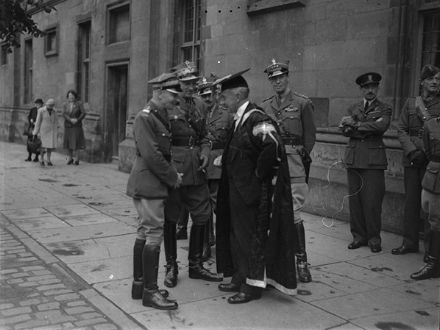
King Peter of Yugoslavia visits the University of St Andrews, September 1941. Above, on South Street outside Parliament Hall and St. Mary’s College gate. Below, in St. Mary’s quad.
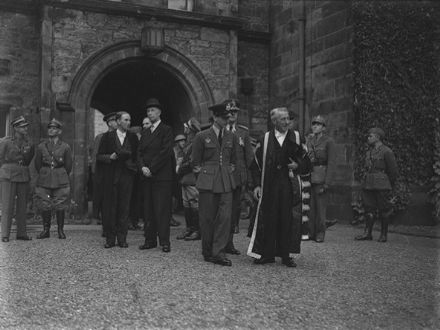
Fighting 69th: Home for St. Patrick’s Day
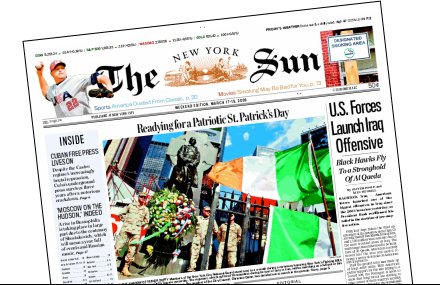
IN THE SHADOW OF FATHER DUFFY: Members of the New York City National Guard (sic) stand next to a wreath during a ceremony honoring New York’s Fighting 69th at Times Square’s Father Duffy Square (sic) yesterday. The regiment, which suffered 19 casualties during its tour of duty in Iraq, will be marching as a full unit in this year’s St. Patrick’s Day Parade on Fifth Avenue. The speaker of the City Council, Christine Quinn, has decided not to march in the parade. Story, page 3.
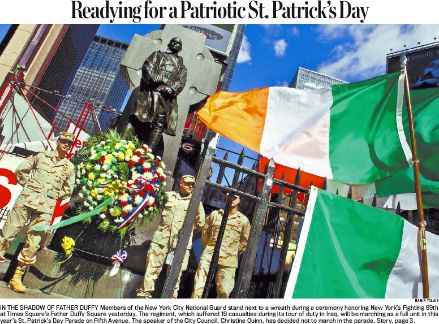
Despite the inaccuracies (it’s the New York National Guard, not New York City National Guard, and Father Duffy Square is opposite Times Square, not in it), it’s nice to see one of the Empire State’s greatest regiments remembered in the press, and on no less than the front page.
Further:
A Pat on hero’s back — Fighting 69th vet to lead parade in honor of slain pal (New York Daily News)
The Rectorial Festivities
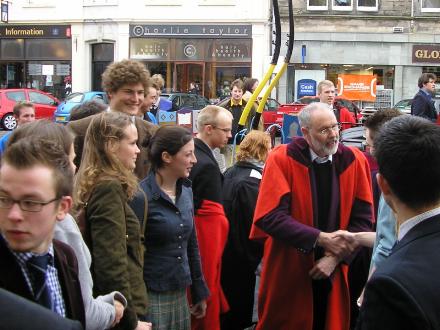
How one enjoys the traditional and ceremonial side of university life! Having duly elected Simon Pepper OBE as the new Lord Rector of the Universitas Sancti Andreae, the usual rigamarole of festivities and rites recently took place. The first is the Rectorial Drag, in which the Blues of the University drag the new Lord Rector around the town in a carriage. Along the way he makes various stops, mostly at public houses, in which a number of student groups and the like present him with gifts and drinks. We in the Boat Club arranged to meet the Lord Rector at the Central bar in Market Street. Above (and below), having alighted from his carriage, the Lord Rector greets a number of students, among them Felix Lobkowicz, the recently-elected President of the Boat Club, and Chris Kololian, the outgoing president. (more…)
Thoughts of Late
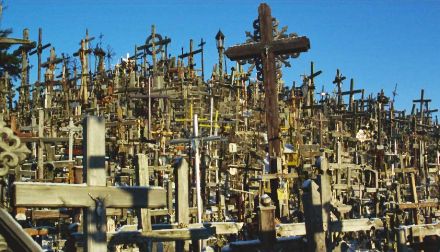
The Hill of Crosses in Lithuania. Over the years, the faithful left crosses on this hill to praise God and signify their appreciation for the many graces and mercies bestowed by Him. During the Soviet occupation of Lithuania, the hill was twice demolished and cleared by the Communists. Each time it was reconstructed by the people, and on its third appearance the Soviets finally allowed it to stay. Despite strong evidence of Christian faith such as this, the University of St Andrews ‘Christian Union’ claims that Lithuania is a heathen country, ‘with only 35 Christians’.
 During my presence at St Andrews over four years, it has snowed on a few occasions, though never stuck for more than a few minutes. I was much pleased, then, to awake on March 2 and spy through my windows (I never draw the curtains, as I enjoy the early morning sun) a blissful wintry utopia. The auld gray toon had been transformed into a veritable snow-globe, with snowflakes shifting back and forth with the wind as gravity drew them nearer their earthly home. Delightfully, this snow lasted, affording thousands of students myriad opportunities for heavenly mischief and giving me an excuse to put on my trusty Sportos. (Trusty Sportos seen at right).
During my presence at St Andrews over four years, it has snowed on a few occasions, though never stuck for more than a few minutes. I was much pleased, then, to awake on March 2 and spy through my windows (I never draw the curtains, as I enjoy the early morning sun) a blissful wintry utopia. The auld gray toon had been transformed into a veritable snow-globe, with snowflakes shifting back and forth with the wind as gravity drew them nearer their earthly home. Delightfully, this snow lasted, affording thousands of students myriad opportunities for heavenly mischief and giving me an excuse to put on my trusty Sportos. (Trusty Sportos seen at right).
But, woe of woes, I had a presentation to give that afternoon on the mundane and irascibly dull subject of the historiography of Indian/Settler relations in colonial America. I, and about four or five others out of a class of nearly twenty, duly arrived in the Old Library of St. John’s House at the appointed hour. We, the few, pondered where everyone else was. Had they autonomously declared a holiday? Risky business, considering this was a tutorial, and thus required, unlike lectures, of which I likely attended less than a third of my due during the past four years. A kindly secretary came in to inform us that Dr. Hart had cancelled the class and thus we were all free to frolic in the abundant snow to our little hearts’ content. Naturally, I just went to Rosary.
Speaking of Rosary, one day the week previous the post-Rosary revelry nearly drank the town dry. Well, perhaps I ought to give some background to our bliss. The Rosary is said every day Monday through Friday in St. James Church at 1:30 after which we all process across the street to the Common Room in Canmore. One or two of the girls, or Adrian if the girls are absent, make a round of tea for the merry band of Marian devotees. Well, on this frigid day in Scotland (a land of poorly-heated buildings, if one’s lucky enough to have heating on at all), we all huddled by the electric fire in our chairs, surmounted by a large communal blanket. Tom brought a bottle of port, of which we all partook, before I then excused myself to go off and do some equally time-wasting task. Well apparently the Rosary crew finished off that bottle of port, and then went and purchased another one! What’s more, the rapacious dipsomaniacs, once they had finished that bottle of port they emptied the reserve bottle of whiskey I keep hidden behind the German dictionaries in the library upstairs. Disgraceful! I have decided not to replenish the secret reserve, since, to put it in the vernacular parlance, is nae secret anaemoor!
Of course it’s my own fault for leaving it in the Chaplaincy. Should I have hidden it in the chaplaincy of the very friendly heretics over in St. Mary’s Place across from the Students Union, it would have remained unmolested. The worse that could happen would be the Christian Union forming a prayer circle around it and praying for the Good Lord to make it go away. (We Catholics already posess the knowledge on making drink disappear, and how!).
Ah, the ‘Christian Union’! Not in the entire English-speaking world, I daresay, does there exist a more delusional body of people. Everything about them is either hilariously funny or pitably sad, beginning with the irony of their very name. The Christian Union, as it styles itself, actually bans most Christians from joining. Those who wish to sign up (poor fools!) must be willing to sign a statement of faith extolling the tenets of the Evangelical Protestant religion. Thus Catholics, Orthodox, and even most Anglicans are not allowed to join. I have sometimes posited contacting whichever bureau of Britain’s behemoth government is responsible for truth in advertising and trying to get them to get the Christian Union to change their name. ‘Evangelical Society’ would be the most appropriate; while ‘Society of Over-Emotional Self-Deluding Followers of Feel-Good Teddy-Bear Christianity’ might be more accurate we must give some allowance for PR these days.
One of the latest projects of the Christian Union is to work for the ‘Christianization’ of Lithuania, “since there are only 35 Christians in the entire country”. It has apparently escaped the C.U. that Lithuania was Christianised ten centuries ago and has remained a vibrantly Christian country, even through decades of Soviet persecution. But perhaps we should leave them in their self-delusion, if only for the hilarity it provides for the rest of us. One can almost imagine them being given demographic information about the population of heaven, with thousands upon thousands of the patriarchs and prophets of the Old Testament, the apostles, the Church fathers, the martyrs, confessors, priests, nuns, and all the legions of holy souls: “But there are only 35 Christians!”
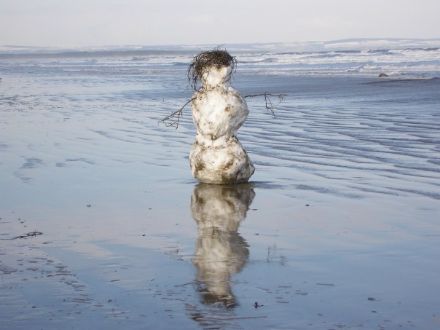
St Andrews Snowfall
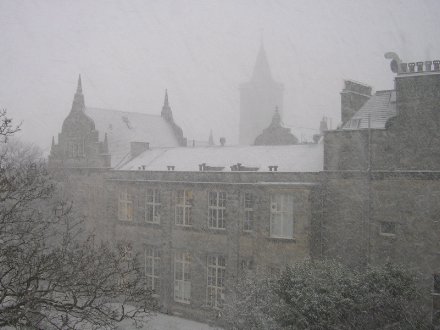
In an act of worship of the goddess Effeciency, the U.K. Government, or the Meteorological Office thereof, declared March 1 to be the beginning of Spring rather than the traditional, astronomical, and accurate Vernal Equinox (March 20). True to form, Mother Nature (a proud woman), decided that, in the interests of putting the upstarts in their proper place, she would open the heavens and thus a bountiful snowfall was produced the ver next day. I took a few snaps from my little chamber in St. Salvator’s Hall for your enjoyment. (more…)
Search
Instagram: @andcusack
Click here for my Instagram photos.Most Recent Posts
- Amsterdam November 26, 2024
- Silver Jubilee November 21, 2024
- Articles of Note: 11 November 2024 November 11, 2024
- Why do you read? November 5, 2024
- India November 4, 2024
Most Recent Comments
Book Wishlist
Monthly Archives
Categories

